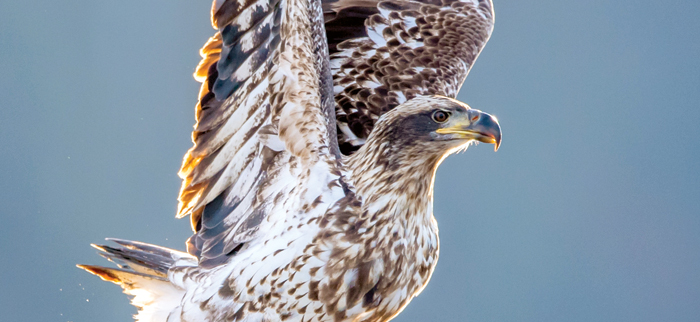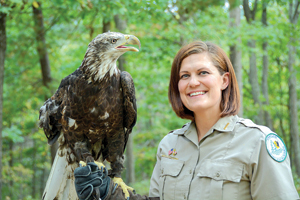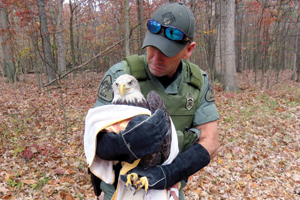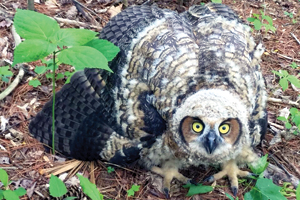Prey for Rescue: Officer training extends to handling raptors

Immature bald eagle; by William Pully
Vulnerable, yet often still powerful, injured birds of prey pose many challenges to would-be rescuers.
Whether it is a struggling bald eagle whose water-logged feathers prevent it from lifting off from a river or an osprey left dazed after flying into a plate-glass window, raptors are great forces of nature, capable of striking with formidable talons and beaks.
A natural lesson
In a new program, Maryland Natural Resources Police officers are being taught to perform raptor triage, providing a bridge to get birds in trouble out of danger and into the care of a regional network of trained volunteers and rehabilitation specialists.
“The public looks to us to have answers. It’s nice that we now have the training and confidence to help these injured birds,” says Cpl. Chris Neville, one of the first officers to take the course.

Ranger Milbourne with eagle; by John Zinke
The curriculum is built on the 30-year foundation provided by the popular Maryland Park Service Scales & Tales program, which introduces the public to birds and reptiles that have been rescued but are unable to live in the wild. Scales & Tales education programs are set up at several state parks, including Cunningham Falls, Rocky Gap and Tuckahoe.
The collaboration is a natural extension of the relationship between the parks and the officers who patrol them. Many calls about injured birds come on nights and weekends, meaning officers are often the first on the scene, says Sarah Milbourne, the manager of Rocky Gap State Park, who crafted the curriculum.
“It’s not easy. These birds can be intimidating, even when they’re injured. They’re powerful, they’re big and they’re athletic. They sense so much, whether it’s fear or indecision,” Milbourne says. “They are unpredictable, especially if they’re cornered or starving.”
Training
Officers learn how to approach an injured raptor, how to use the terrain and other people to close off escape routes, how to assess an injury, and how to place a wounded animal in a carrying box.
“The hardest cases are the animals that are hurt but still have some spunk in them. The officers don’t want to put the animal in danger, but they don’t want to be maimed for life, either,” Milbourne says. “We are empowering them to save wildlife.”
Already, the training is paying off.

Cpl. Doug Feller practicing handling a Scales & Tales eagle
Just days after completing training last summer, Officer First Class Amelia Nelson was on patrol on the South River in Anne Arundel County when she received a call about an injured osprey on the second floor of a home on Aberdeen Creek.
She docked her boat and went to the house, where she found the bird, one wing slightly drooping, cowering on a porch. “The bird was the size of a baby and the talons—they were huge,” Nelson recalls. “The closer I got, the bigger she tried to make herself.”
Tapping into her training, Nelson asked the homeowner for a towel, which she draped over the osprey to calm it and keep its wings from flapping. Pointing the bird’s powerful talons away from her body, Nelson called Officer First Class Brian Hunt for assistance.
The two officers took the bird they nicknamed Hemingway by boat to a volunteer raptor caregiver, where it stayed overnight until it could be driven to Owl Moon Raptor Center in Montgomery County.
In late summer, recovery time is of the essence because osprey are about to begin their long migration to the Southern Hemisphere for winter. Expert treatment meant Hemingway did not miss its flight.
Nelson was elated to put her training to use right away. “I was so happy. I was so proud to be an officer. It was one of the best experiences, ever,” she says.
Another save
Weeks later in Western Maryland, Officers First Class Marty Kaetzel and Cory Garver got that same feeling of accomplishment when they helped Milbourne corral a bald eagle that had been struck by a truck on I-68. With the officers looking on, that eagle was rehabilitated and released after just a few short weeks.
“Once you have that first save, you get the confidence to handle the next one,” Milbourne says.
Officers who take the training are given nets, welder’s gloves, towels and carrying boxes. They also receive a list of rehabilitators and advice on how to house a bird overnight if immediate transportation cannot be arranged.

Not hurt, just learning to fly. Officers must be able to assess various situations. By Sarah Milbourne
The highlight of the training comes when officers put on their welder’s gloves and experience the grip of a raptor—a red-tailed hawk or an owl—perched on their forearm.
“It was a surprise to find out how powerful they really are,” Neville says. “Even with the gloves on you could feel their strength and you see why they’re such extraordinary animals and apex predators.”
Positive outcomes
The training proved to be rewarding in other ways, too.
“A lot of times when we get these calls we know we’re going to have to put the animal down. It’s part of the job, but it’s not an easy part,” says Officer McKenzie Divelbiss. “When we get a chance to help a bird, to give it a second chance—that’s a really good feeling.” The goal is always to return a bird to the wild. But both the officers and trainers know that despite their best efforts, they aren’t always going to experience that happy ending.
“Even if the bird doesn’t live, we know that in its last moments it was safe and as comfortable as possible,” Milbourne says. n
Article by Candy Thomson—Natural Resources Police public information officer. Appears in Vol. 21, No. 1 of the Maryland Natural Resource magazine, winter 2018.


 1-888-373-7888
1-888-373-7888 233733
233733